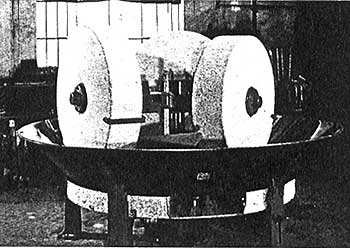 |
[ZAWiW] [gemeinsamlernen] [LiLL] | ||
|
|
|
|
| home | ||
|
|
Bread in Life and Art | |
|
|
Bread Dough as Art | |
|
|
Maquila | |
 |
||
Maquila
Stand:
We thought that it was a wise move on his part to make this classic barter,
paying with a sack of bran for the work of the miller and taking a sack of white
flour home.
This barter is what is called ¨maquila¨ (from the Arab word for measurement). It
describes the amount of grain, bran or flour which the miller receives for the
milling, or the amount of bread which the baker receives for baking the bread
for a family
¨Maquilar¨ means to collect this payment, and the person who collects it is
known as the ¨maquilero¨.
In the years following the end of the war, there were two types of bread: white
and black.
Black bread was made from rye flour (a dry grain plant very similar to
wheat, which has a high nutritive value, and which is also used in the
fabrication of alcoholic drinks and of paper). It is cultivated in poor soil,
where the yield from wheat would be very low. It is cultivated for its grain,
for straw, and for green forage. Rye flour is less white than wheat flour and
makes dark bread, which stays fresh for some time.
White bread is bread of high quality, made with wheat flour.
Whole grain bread is made from wheat flour, which is mixed with the bran, and it is brown in colour.
 Stone mill |
 Grinder |
History:
In days gone by, la maquila was the payment, in ground wheat, which the
people who lived on the lands of the local nobleman had to pay for grinding
their wheat in the mill of the nobleman, who had the monopoly.
Translation: Margaret Craig
